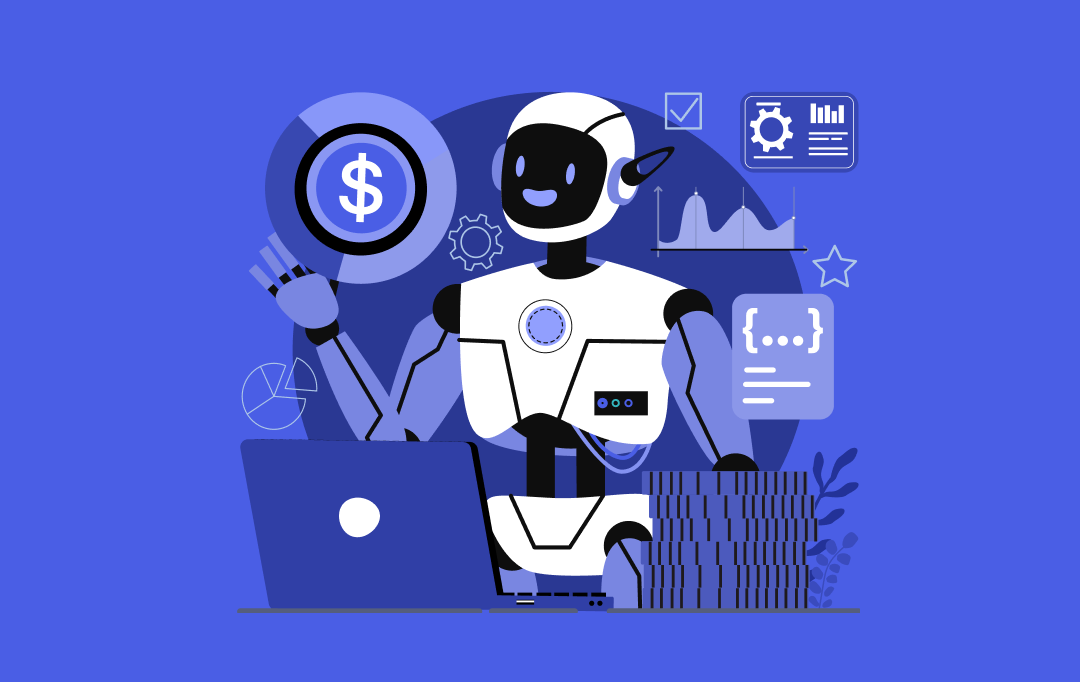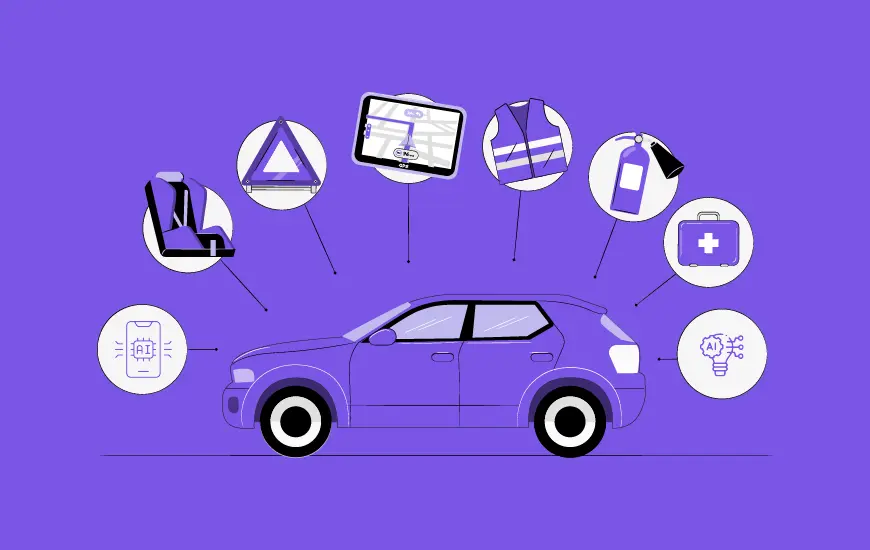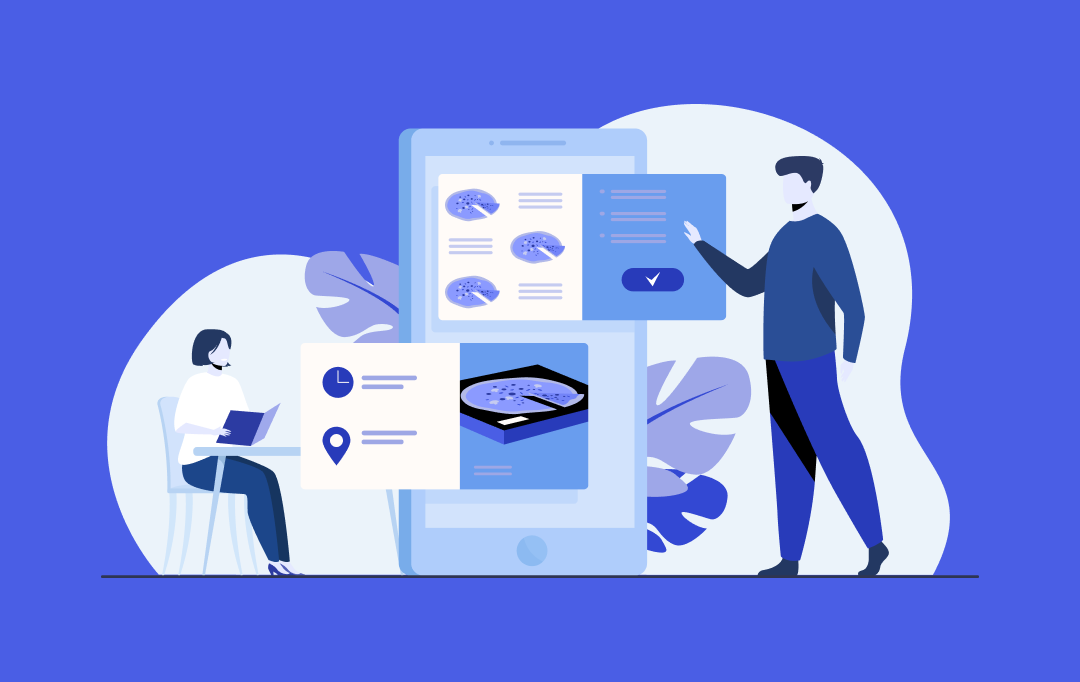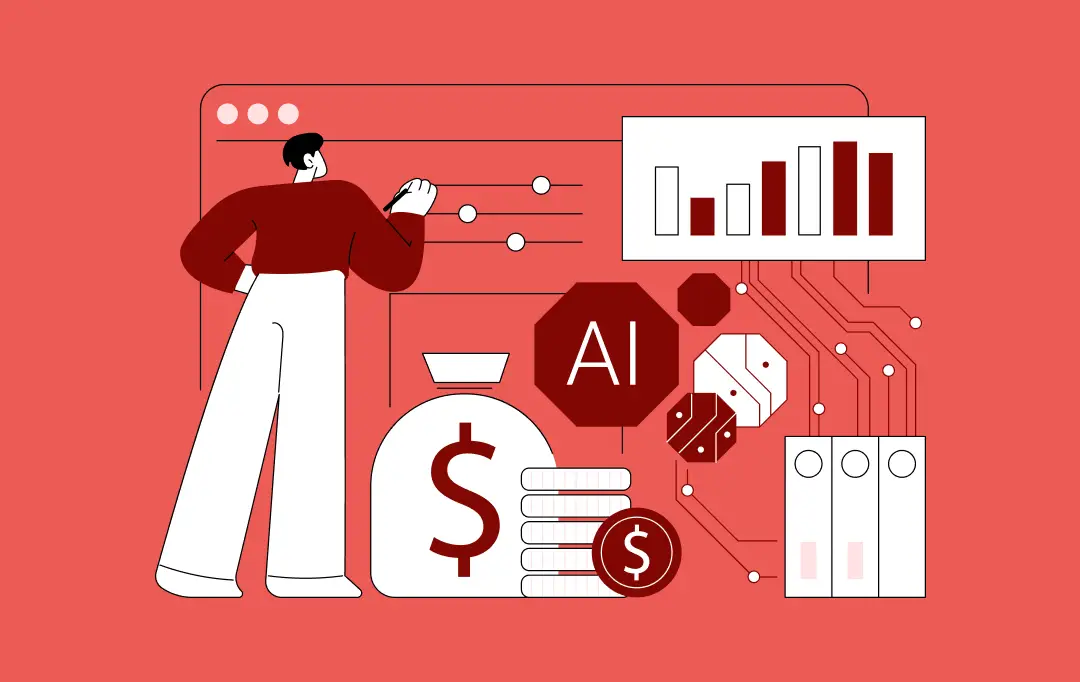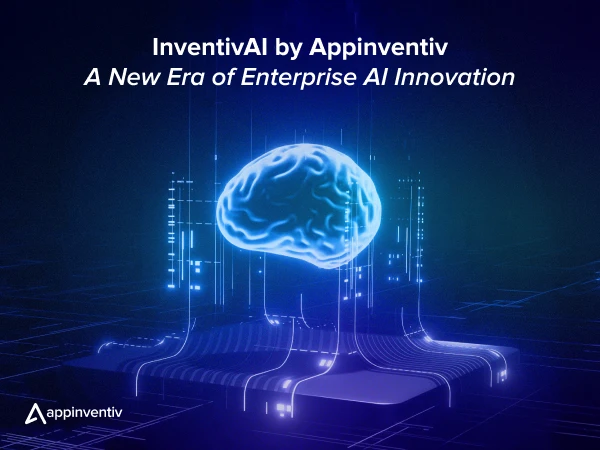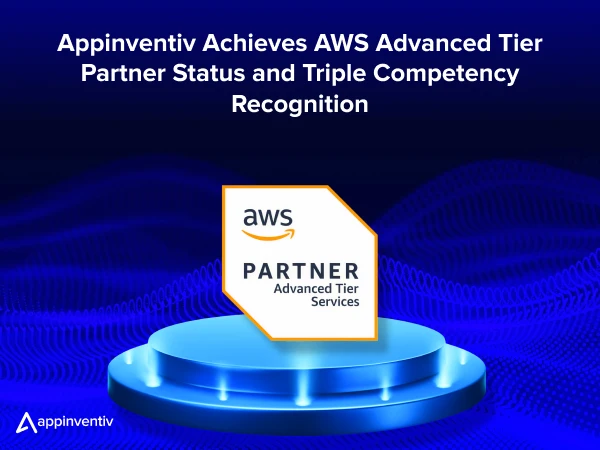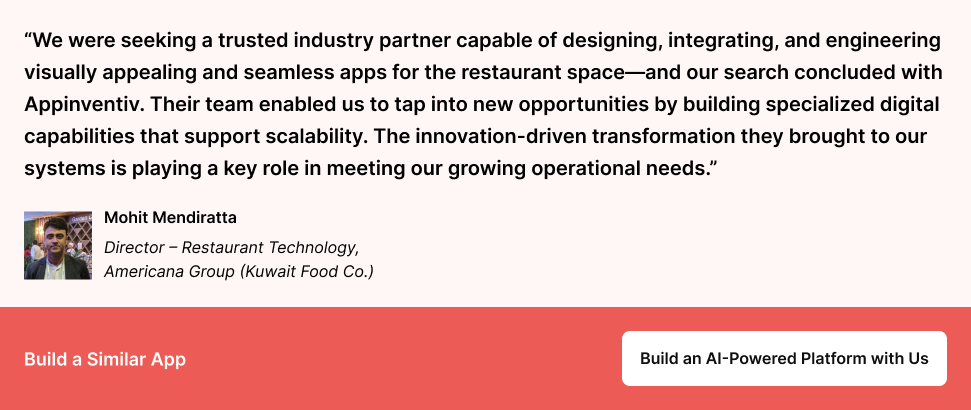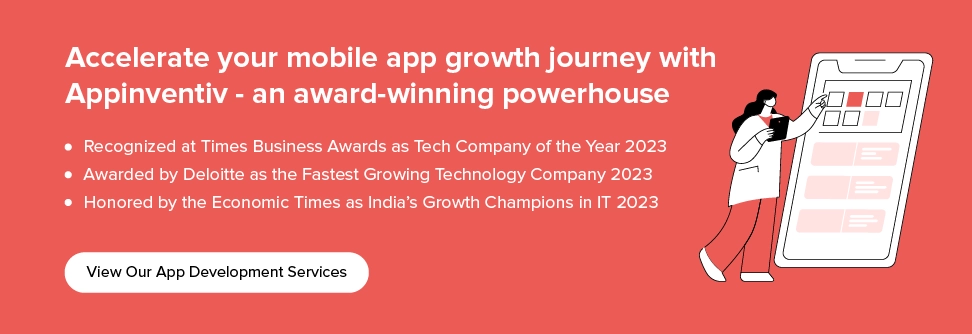- Why Should Businesses Leverage Mobile Application Development: A Quick Glimpse Into Multifaceted Benefits
- Provide More Value to Customers
- Build a Stronger Brand
- Achieve Increased Customer Engagement Level
- Have a Competitive Edge in Your Niche
- Build a Personalized Marketing Channel
- Improved Customer Retention
- Instant Feedback and Insights
- Scalability
- The Roadmap to Successful Mobile App Development Process
- Define Your Goals
- Research the Target Market
- Finalize Your App Features
- Choose Intuitive UI/UX Design
- Hire an App Development Company
- Build MVP
- Test Your App
- Launch Your App
- Post-Launch Activity
- Understanding Frontend and Backend in Mobile Application Development Lifecycle
- Mobile App Development Tech Stack: Tools Behind Powerful Apps
- Frontend (Mobile App Frameworks)
- Backend (Server-Side Technologies)
- Database Technologies
- Cloud Infrastructure & DevOps
- Security & Authentication
- Testing & Quality Assurance Tools
- Analytics & Monitoring Tools
- Building a Secure and Compliance-Friendly Application for Your Business
- Types of Mobile App Development Businesses Can Explore
- Native App Development
- Cross-Platform App Development
- Progressive Web App Development
- Hybrid Mobile App Development
- How Appinventiv Helped KFC Launch 7 Mobile Apps in a Single Year Leading to Massive Results?
- Mobile Application Development Trends Businesses Need To Look Out For
- Generative AI
- Internet of Things (IoT)
- 5G
- Augmented Reality and Virtual Reality
- Predictive Analytics
- Artificial Intelligence (AI) and Machine Learning (ML)
- Edge Computing
- Blockchain
- Voice Technology & Natural Language Processing (NLP)
- Cloud-Native Mobile Apps
- Who Should You Entrust Your App Development Process to?
- How to Choose the Right Mobile App Development Company
- Company Analysis
- Questions to Ask Potential Development Companies
- Mistakes to Avoid When Developing Mobile Applications
- Key Considerations Before Developing a Mobile App
- Platform Choice: iOS vs. Android vs. Cross-Platform
- Budget and Timeline
- Security and Regulatory Compliance
- Scalability and Future-Proof Architecture
- User Experience (UX) and Interface Design (UI)
- Backend Infrastructure & Third-Party Integrations
- Post-Launch Support, Testing, and Maintenance
- Monetization and Revenue Strategy
- Understanding Cost of Mobile App Development
- Mobile App Monetization Strategies for Businesses
- In-App Purchases and Subscriptions
- Freemium Models
- Ad Monetization
- Sponsorships and Partnerships
- Mobile App Development for Businesses: Issues That Arise and How to Resolve Them
- High Development Costs
- Maintaining App Security
- App Store Rejection
- App Performance and Scalability Issues
- Device and OS Fragmentation
- How Appinventiv Can Help in Your App Development Journey
- FAQs
Key takeaways:
- By 2026, the number of mobile app downloads is expected to surpass 180 billion, highlighting the untapped potential for businesses to leverage mobile apps in reaching a massive global audience.
- Mobile apps generate more than just user engagement—businesses can utilize advanced AI and machine learning to provide hyper-personalized experiences, boosting conversion rates significantly.
- Statista projects mobile app revenue to hit $781.7 billion by 2029, with a substantial portion driven by in-app purchases and subscriptions, signaling a shift from traditional business models to recurring revenue.
- Developing a mobile app isn’t just about reaching customers; it’s also about collecting data that can refine product offerings, improve customer service, and drive long-term innovation.
What began as a small collection of utilities and games has now become a cornerstone of digital life, powering everything from entertainment and social interaction to finance, healthcare, retail, and enterprise productivity.
Just over 15 years ago, the mobile app economy was little more than a promising idea. A handful of apps, basic user experiences, and early monetization experiments defined the landscape. Around that time, Steve Jobs famously speculated that the App Store might someday become a billion-dollar business. Fast forward to today, and that vision has been vastly outpaced.
According to data.ai’s Mobile App Market Forecast 2030, the mobile app economy—spanning iOS, Google Play, and third-party platforms is now on track to generate a staggering $2.2 trillion in global revenue between 2021 and 2030.
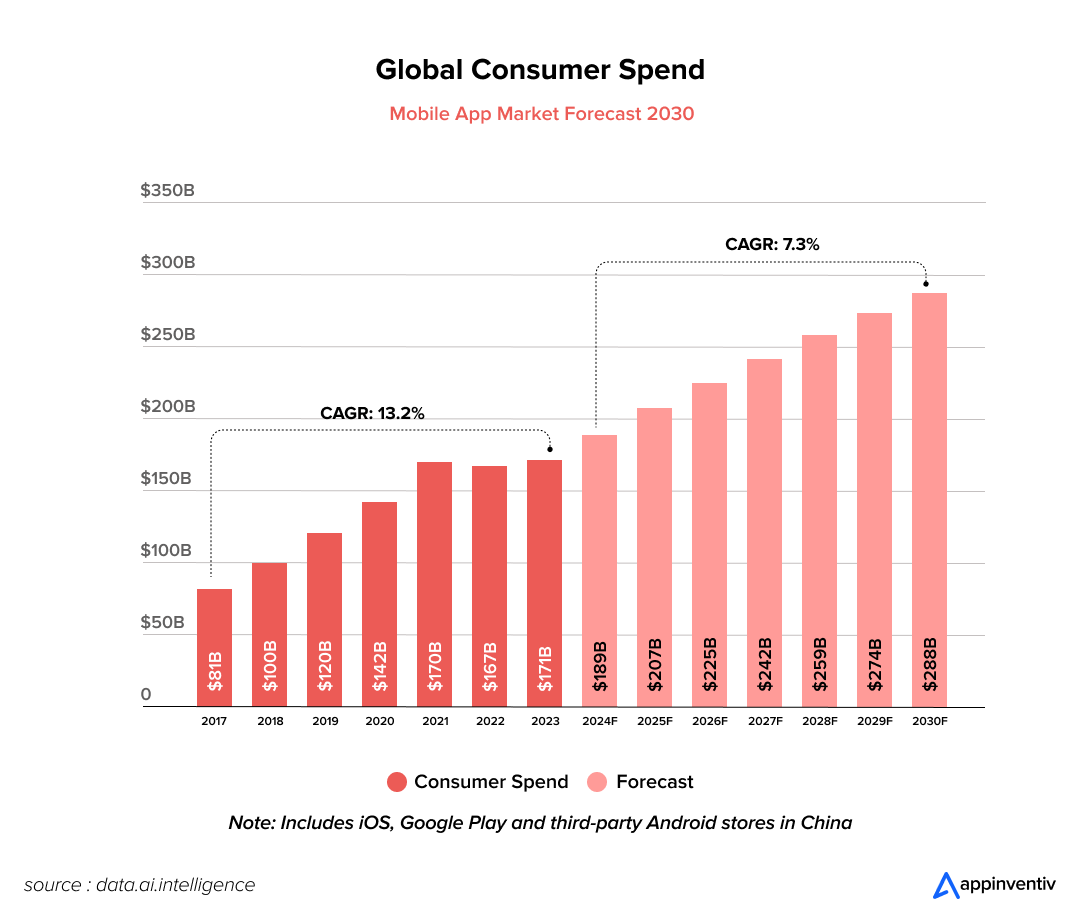
This surge is powered by growing smartphone adoption, deeper user engagement, and the widespread embrace of mobile-first solutions across industries like healthcare, fintech, entertainment, and retail.
Again, Statista reported that in 2026, consumers are projected to download 143 billion mobile apps from the Google Play Store and approximately 38 billion apps from the Apple App Store. Furthermore, the total revenue generated by mobile apps is also expected to reach $781.70 billion by 2029, pointing to a rapidly expanding market.
Simply put, the unprecedented surge in app downloads and the expected revenue to be generated by the apps signifies that now is the right moment to bring your digital vision to life and capture the momentum of this digital wave. Whether it’s finding smart solutions to everyday issues or inventing completely new ways for people to experience the digital world, the possibilities for innovation in 2025 and beyond are unlimited.
Our blog will help you deep dive into everything you need to know about mobile application development for your business. From exploring various app types and understanding their benefits to the underlying development process and overall costs, this mobile app development guide will help you in navigating the journey of bringing your app idea to life.
Don’t let your business miss out on this momentum
Why Should Businesses Leverage Mobile Application Development: A Quick Glimpse Into Multifaceted Benefits
Mobile apps have become an indispensable entity for businesses of all sizes, be it a startup or an established titan. As a business owner, ignoring the benefits of leveraging mobile application development means missing out on opportunities for growth and engagement. Below are some of the key benefits of mobile app development:
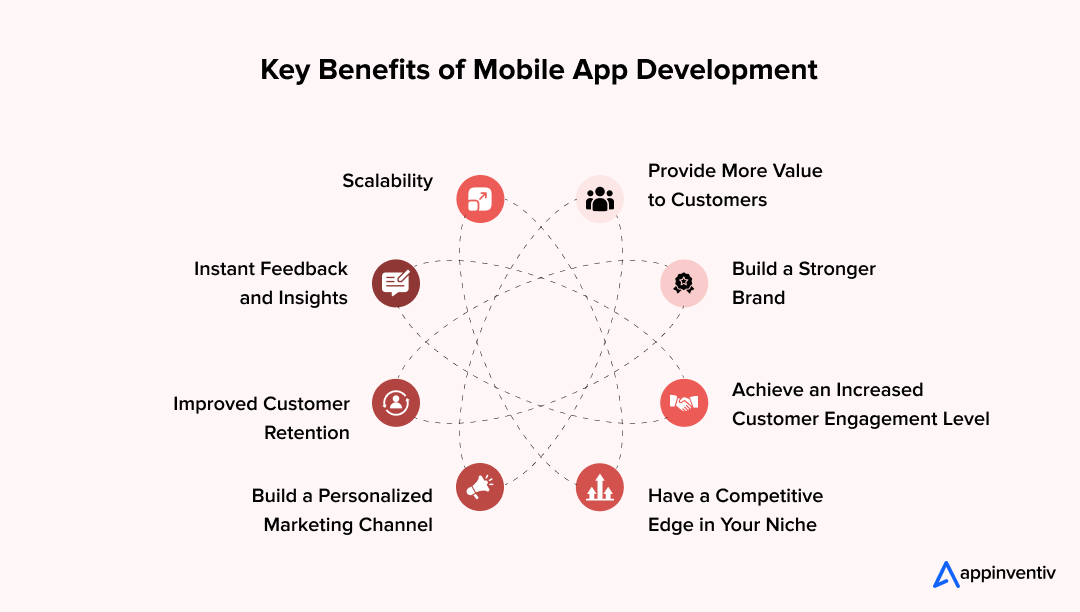
Provide More Value to Customers
In the past few years, the business landscape has changed significantly. Businesses now rely heavily on technology to initiate and complete transactions with consumers. Here comes business application development!
Mobile apps are an integral element of modern tech that is constantly changing how consumers shop and satisfy their requirements. With the increasing pace of technological advancements, consumer expectations are also growing. Thus, mobile apps have become a great channel for meeting those user expectations.
For instance, retail shopping is one of the key business categories that benefit the most from mobile apps. By shifting to retail mobile apps, you’re sure to make your goods and services more accessible and easy to use.
For instance, at Appinventiv, we built an ERP application for IKEA, the world’s finest furniture retailer, that gave customers the real-time status of products’ availability and allowed the brand to gather customer information for marketing purposes.
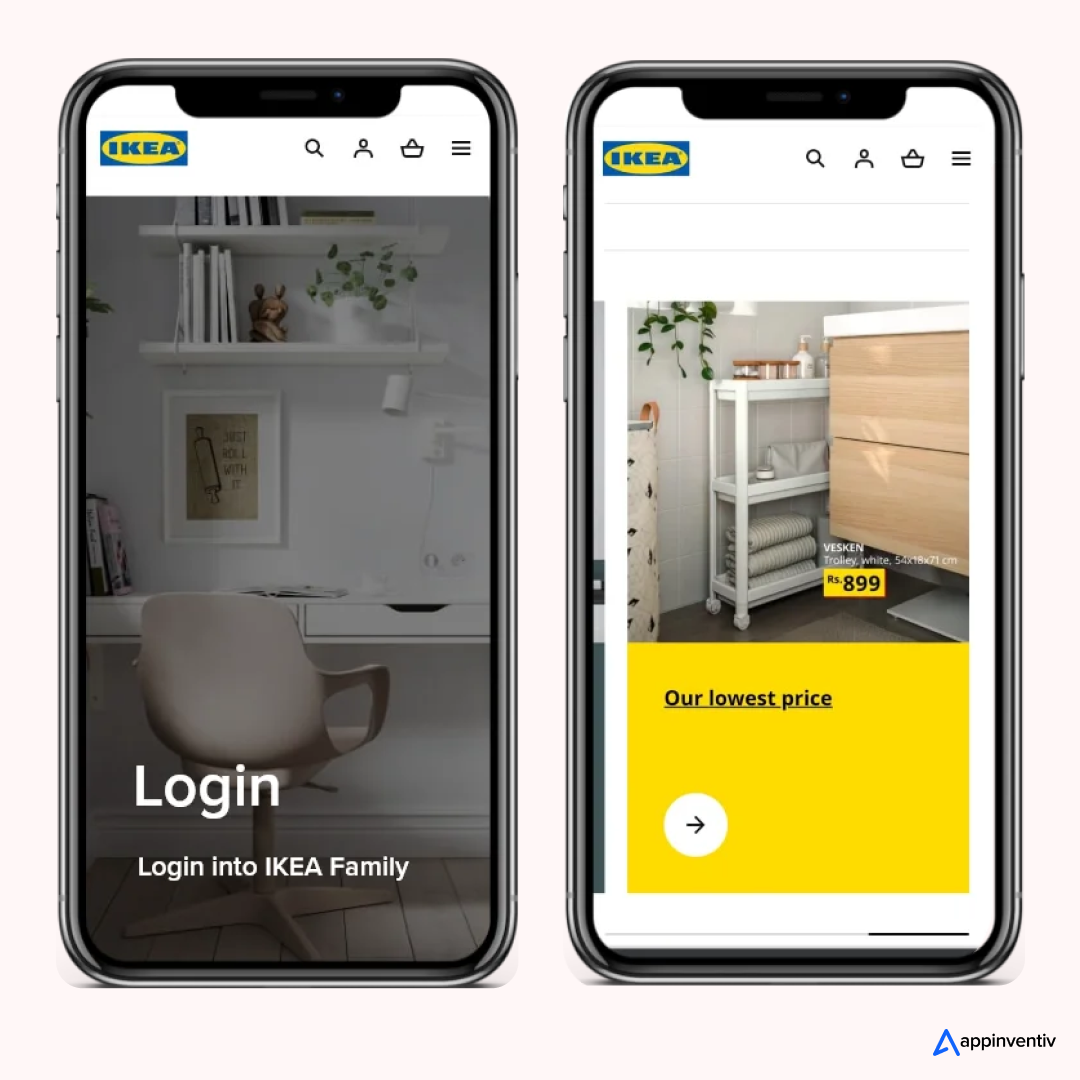
Our efforts led to the creation of a solution that has been adopted at over 7+ IKEA stores. The brand also touts the solution as one of the biggest sources of ROI measurement.
The example of IKEA demonstrates how modern consumer behavior prioritizes personalization and convenience, and apps make that available at the customer’s fingertips.
Build a Stronger Brand
The more value you offer to your customers, the more interest they develop in your brand. However, it’s impossible to achieve a deep brand experience without deliberate branding efforts. This is where branded mobile apps come into the picture.
Mobile apps are becoming an innate part of our everyday lives. App owners can utilize this channel to their brand’s benefit. The more branding elements you get right within your app, the better the impact you can expect on brand marketing results. You can even collect data from this app to understand your target audience better and improve your brand marketing strategy.
Achieve Increased Customer Engagement Level
One of the best ways to increase revenue generation and brand awareness is to focus on improving the customer engagement level. If you successfully increase the frequency at which your customers engage with your brand, you will experience an increase in ROI, customer lifetime value, and other key metrics. For app owners seeking to boost engagement levels, it is essential to incorporate certain innovative features during the business application development process.
Perhaps the most important for them is segmented targeting. This includes creating multiple user categories and controlling the type of content delivered to each segment of users. User segmentation allows you to provide accurate recommendations, send personalized messages, and understand your customers’ journey better.
Other in-app elements that can help achieve higher customer engagement level include loyalty programs, continuous features updates, and discounts. Apart from the features, it’s crucial to pay attention to UI/UX design. A poor UI may compel your users to uninstall your app and move to a similar and better app.
Have a Competitive Edge in Your Niche
In the ever-changing digital landscape, it’s pretty tough to keep up with your competitors. A mobile app gives you a significant edge over your competitors. Compared to conventional websites and digital platforms, mobile apps do a much better task when it comes to offering speedy communication and enhanced customer experience.
Considering the number of ways a mobile app strategy can improve your business processes, its overall effect on your revenue generation will eventually become evident.
Build a Personalized Marketing Channel
Another area that can benefit a lot from a business mobile app development is the marketing department. The first and foremost advantage digital marketers enjoy when businesses opt for mobile apps is the direct access to user information.
The data collected from user sessions within the app can be very helpful in improving your marketing efforts and campaigns. Once your marketers get access to all the data they need, an app allows them to deliver more effective and personalized content to users as compared to other traditional marketing channels.
Improved Customer Retention
Mobile apps offer a direct and always-on communication channel between businesses and customers, fostering long-term relationships. Features like push notifications keep users engaged by delivering timely updates, promotions, and reminders.
Personalized content and offers based on user behavior increase relevance and boost loyalty. Unlike websites or social media, apps sit right on the user’s device, making brand interaction more frequent. Over time, this consistent engagement significantly improves customer retention and lifetime value.
Instant Feedback and Insights
Apps enable businesses to collect real-time feedback through in-app surveys, ratings, and direct user inputs. This immediate access to customer sentiment allows for quicker resolution of pain points, improving satisfaction and trust.
Behavioral analytics within the app also reveal how users interact with features, which helps businesses fine-tune the user experience. By acting on real-time insights, companies can adapt faster to market needs and consumer expectations. This data-driven approach leads to better product decisions and increased user retention.
Scalability
A well-designed mobile app can grow in tandem with your business. Whether you’re expanding product lines, entering new markets, or onboarding more users, your app can scale to meet the demand. With cloud-based infrastructure and modular architecture, updates and new features can be rolled out efficiently.
Mobile apps also allow for automated workflows and integrations that reduce operational load. As customer base and expectations grow, scalable apps ensure performance remains seamless and experiences consistent.
After looking into various benefits of app development for business, let us now move ahead and understand how to build a mobile app in detail below.
The Roadmap to Successful Mobile App Development Process
If you’re wondering how to develop an app to enhance your business or launch a new idea, here are certain steps you should consider before the development begins. These steps are crucial to the success of your application, so don’t skip over them.
For teams building beyond a single app, following a structured software product development process helps align mobile initiatives with long-term scalability, cost control, and product evolution.
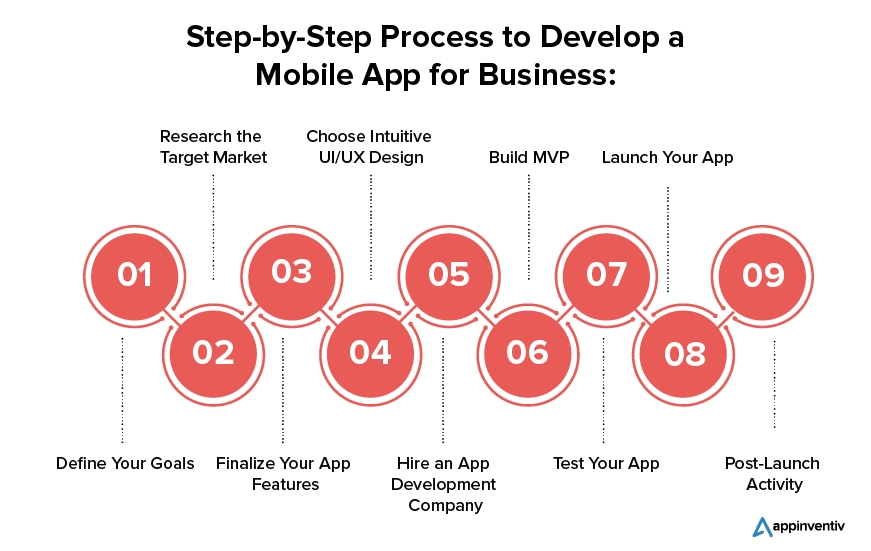
Define Your Goals
When starting with the mobile app development process, you must have clarity regarding your goals.
What is your mobile app business plan? setting out to achieve? What problems are you trying to solve with your application? Your goals will ultimately determine your entire app development process. If these aren’t clearly defined from the start, it’s easy to get lost along the way once you start building your app.
Don’t set any goals – set measurable goals. Otherwise, you won’t be using your time and resources effectively. You can set goals related to the end-users as well as your business. Every goal should have clear KPIs to measure and track its success.
For instance, let’s say you want to build an app for your e-commerce business. Your goal might be to reduce shopping cart abandonment rates on mobile devices. To ensure that you achieve this goal, you must know your current abandonment rates to measure them against the numbers when you eventually launch your own app.
Research the Target Market
When developing a mobile app for business, you need to conduct research and find out more about your target market. This will help you understand how consumers interact with brands, leading players, market dynamics, and more. You should also check user reviews for top apps in the market. This will help you come up with a better product. You also need to understand your target audience. Learn about your users’ location, average age, and the types of devices they use.
Finalize Your App Features
It’s crucial to have the right features integrated into your app. You have to identify the features that are necessary to serve your users in the best possible way. While adding popular features to your app might sound attractive, unnecessary features may leave your users frustrated.
Furthermore, the more features you add, the more it will add to the cost and lengthen the mobile development time. So, it’s advisable to focus on simplicity in the early development stages.
Choose Intuitive UI/UX Design
What is the first thing your customers see when they open an application? It’s not the features but the way your app looks and interacts with users. User-friendly and easy control of app’s features is what makes it appealing to its users. The app functionality is useless if the app users are not able to actually implement it in real life. This will leave them frustrated, and they will move on to another application.
While user interface (UI) refers to how your mobile app represents itself to the user, user experience (UX) is how the user interacts with the app and gives commands to complete or solve the issues that the app was originally built for.
Your app’s effectiveness can be measured by the optimal combination of its attractiveness and functionality. Considering this, make sure the mobile app for your business follows the below-mentioned basic rules:
- It’s intuitive
- It’s simple
- It’s engaging
- It does what it says it will
When implementing trendy mobile app design, make sure that it not only looks beautiful but interacts with the user and makes the use of the application fast and comfortable.
For instance, we developed an innovative mobile app for Pizza Hut for their Middle-East users. As a renowned organization offering dedicated mobile app development for enterprises, we built an engaging UI/UX for the pizza joint, allowing users to easily navigate and order food in a few clicks.
Furthermore, our team integrated unique features to automate food ordering and delivery right at the customer’s doorstep, eliminating unexpected delays. The app has been downloaded 50k times to date, and the conversion rate has increased by 30%.
Hire an App Development Company
Hiring a reliable app development company will ensure that your app includes all the latest functionalities and features at affordable costs. A dedicated team from a reputable mobile app development company generally includes UI/UX designers, project managers, app developers, and market specialists who always consider your vision and offer valuable suggestions.
In addition, hiring a leading app development firm can also help you leverage its industry expertise and the latest technologies, paving the way for a more seamless, innovative, and user-centric app experience.
Build MVP
An MVP, or Minimum Viable Product, is a version of an app that includes only its core features. It’s designed to show users the app’s primary purpose without incorporating all the advanced functionalities. The idea behind MVP app development is that you get to gauge how the millions of app store users accept your app idea before you invest any more money into scaling the app for its next level.
The fact that MVPs give a very clear idea of the app’s worth at low development cost and efforts have made them the first step toward ensuring the success of the app.
A number of brands started off as an MVP and have now become top-notch businesses, such as Twitter, Dropbox, Airbnb, Spotify, and Groupon, amongst others. To get a better hang of the idea, here’s a pocket guide on the minimum viable product. Apart from giving you an in-depth idea of what the concept is about, the guide will also give you the practical steps to be followed to develop an MVP.
Test Your App
When you decide to create mobile apps for business, it’s inevitable to keep testing the app. Test everything from the app’s performance and content to user experience. Proper testing helps reduce the development cost and time, identify bugs, and greatly improve your reputation as a service provider. Furthermore, it is also vital to ensure that robust security measures are implemented.
Regular security testing helps in detecting vulnerabilities early, preventing potential data breaches, and protecting both user data and your business reputation. Implementing thorough security measures and testing these regularly can significantly mitigate risks, enhancing trust in your services.
Launch Your App
Once your app’s testing is successful, you can submit your app to the Apple’s App Store or Play Store. However, when submitting an app on the Play Store or App Store, you need to comply with Google and Apple’s developer guidelines.
You’ll also need to prepare all the necessary app store assets including app descriptions, screenshots, promotional graphics, and privacy policies to ensure your listing is optimized for discoverability. Additionally, your monetization strategy (whether it’s in-app purchases, ads, subscriptions, or freemium features) must align with each platform’s policies, including revenue sharing and transaction handling.
A well-executed launch, backed by strong compliance and optimization, is key to gaining initial traction, downloads, and user trust.
[Also Read: A mini-guide to successful mobile app launch]
Post-Launch Activity
After launching your app on Play Store/App Store, the next and crucial step of the mobile application development process is marketing. If users are not aware of your app, then there is no chance that they will download it.
To spread information about your app and convince your target audience to explore it, consider making informative and attractive videos that can display your app’s core functionality. And do not forget the potential of social media; digital platforms can help you reach every corner of the world. They will deliver people a glimpse of your app and highlight the key features that can simplify their life needs.
After looking into the detailed process of developing an app for your business, let us offer you a quick insight into the mobile app development lifecycle.
Understanding Frontend and Backend in Mobile Application Development Lifecycle
The development of mobile applications involves two critical components: the “Front-End” that users interact with on their mobile devices, and the “Back-End” services that support the application’s functionality. Understanding this lifecycle is essential for creating effective and efficient applications that meet user needs and stand out in a competitive market.
Let us offer you a quick look into the key components of mobile app development below:
| Component | Description |
|---|---|
| Front-End | The part of the app that users interact with directly. It is installed on the mobile device and includes user interface design and local data storage. |
| Back-End | The server-side of the app which is crucial for processing, data management, and essential application services like user management, server-side logic, and integration with third-party services. |
| APIs | Interfaces that allow the front-end of the application to communicate with the back-end services, enabling data exchange and functionality like fetching product info or user data. |
| Data Services | Services that handle the logistical aspects of data management such as storage, retrieval, and updating information necessary for the application’s operation. |
Now, seamlessly integrating the front-end and back-end components is pivotal for the creation of robust, efficient, and user-friendly applications. This integration ensures that the visually engaging front-end can effectively communicate and operate with the powerful back-end services, enabling a complete and functional user experience. Let’s understand how these components interact within the mobile app development lifecycle:
| Component | Responsibilities | Technologies Used | Key Features | Integration Points |
|---|---|---|---|---|
| Front-End | User interface design User interaction handling Local data caching Presentation and animations | HTML/CSS/JavaScript Swift (iOS) Kotlin (Android) React Native Flutter | Real-time responsiveness Intuitive user experience Dynamic content presentation Accessibility features | API calls to back-end Data synchronization Authentication processes |
| Back-End | Data management and storage User authentication and security Server-side logic Integration with third-party services | Node.js Python Ruby on Rails Java .NET | Scalable architecture Secure data handling Efficient data processing Continuous integration and deployment | Serving API endpoints Managing database connections User data validation Handling business logic |
Mobile App Development Tech Stack: Tools Behind Powerful Apps
Building a successful mobile app requires more than just a great idea, it needs the right combination of technologies to bring it to life. A well-chosen tech stack ensures performance, scalability, and seamless user experience across platforms. Below is a breakdown of essential technologies used in modern enterprise mobile application development that ensures business growth.
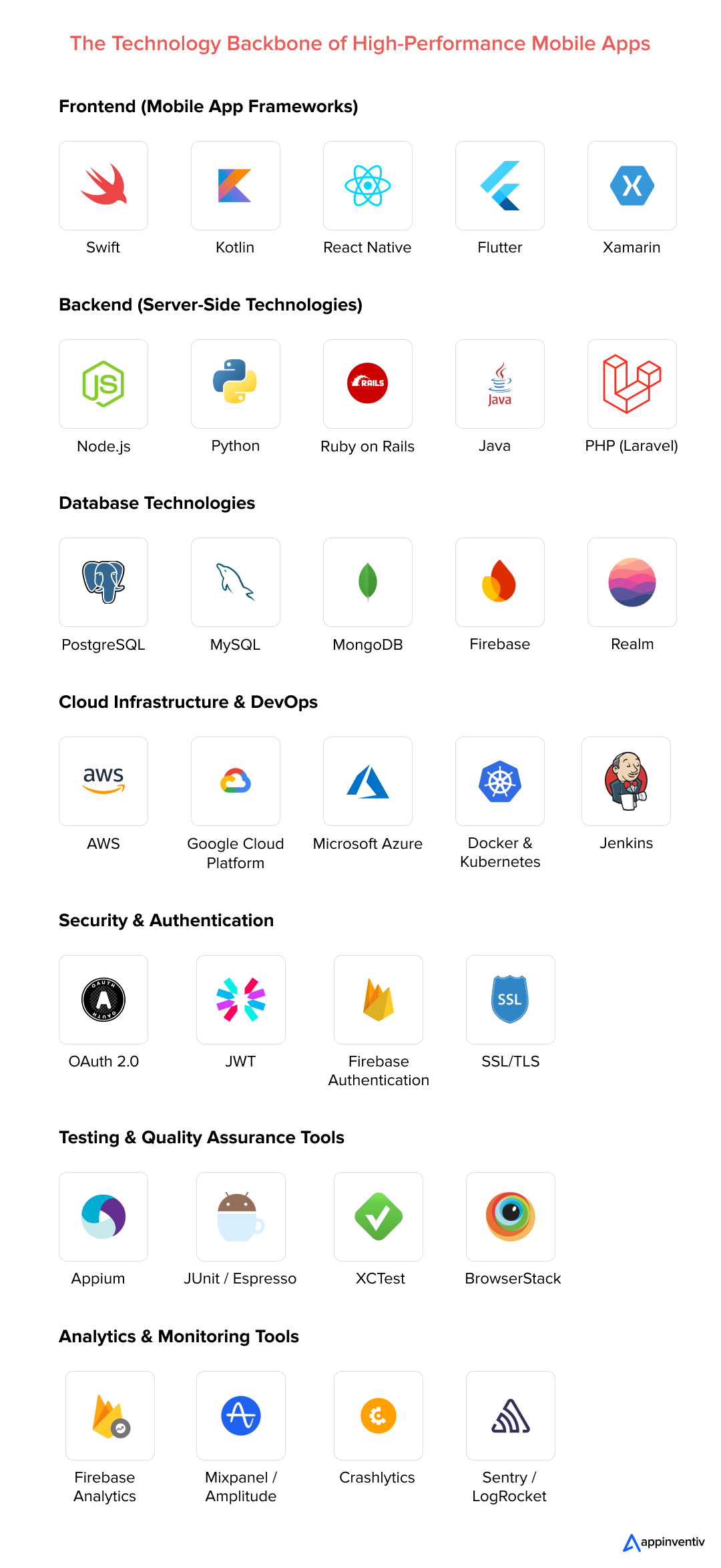
Frontend (Mobile App Frameworks)
The frontend stack focuses on everything the user sees and interacts with. It determines the speed, responsiveness, and overall design experience of your mobile application.
Swift – Native iOS development language by Apple. Fast and secure.
Kotlin – Official language for Android development. Modern and concise.
React Native – Cross-platform framework by Meta using JavaScript. Reusable components for iOS & Android.
Flutter – Google’s UI toolkit using Dart, known for expressive UIs and fast development.
Xamarin – Microsoft-backed framework for building native apps using C#.
Backend (Server-Side Technologies)
The backend stack powers the server, databases, APIs, and all the logic behind your mobile app. It ensures that the app functions as intended and securely handles user data and business logic.
Node.js – Lightweight and fast JavaScript runtime, ideal for real-time features.
Python (Django/Flask) – Great for fast prototyping, APIs, and machine learning features.
Ruby on Rails – Convention-over-configuration web framework for rapid app development.
Java / Spring Boot – Secure, scalable backend for enterprise-grade applications.
PHP (Laravel) – Simple yet powerful backend framework with extensive community support.
Database Technologies
Databases are critical for managing, storing, and retrieving user and system data. Choosing the right database depends on the app’s structure and scalability needs.
Firebase Realtime Database / Firestore – Google’s cloud-hosted NoSQL DB for real-time syncing.
MongoDB – Flexible, scalable NoSQL database, ideal for dynamic applications.
PostgreSQL – Powerful open-source relational database for structured data.
MySQL – Popular and reliable SQL database for transactional apps.
Realm – Mobile-first database for offline-first mobile applications.
Cloud Infrastructure & DevOps
Cloud platforms and DevOps tools are essential for hosting, scaling, deploying, and managing app infrastructure efficiently.
- AWS (Amazon Web Services) – Industry-standard cloud platform for compute, storage, and services.
- Google Cloud Platform (GCP) – Scalable cloud infrastructure with deep Firebase integration.
- Microsoft Azure – Great for enterprise-grade cloud needs, DevOps, and mobile services.
- Docker & Kubernetes – Containerization and orchestration for scalable backend environments.
- GitHub Actions / GitLab CI / Jenkins – For continuous integration and deployment workflows.
Security & Authentication
Security is non-negotiable when dealing with sensitive user information. These tools ensure your app meets compliance standards and keeps user data protected.
- OAuth 2.0 – Standard protocol for authorization.
- JWT (JSON Web Tokens) – Lightweight and secure token-based user authentication.
- Firebase Authentication – Easy-to-implement auth for email, phone, Google, Facebook, etc.
- SSL/TLS Encryption – Standard security protocol for data transmission.
Testing & Quality Assurance Tools
QA ensures the app runs smoothly across devices, OS versions, and use cases. Proper testing improves app reliability and user satisfaction.
- Appium – Cross-platform mobile app automation tool.
- JUnit / Espresso – Unit testing tools for Android.
- XCTest – Native testing for iOS apps.
- BrowserStack / Firebase Test Lab – Cloud-based device testing across OS versions and screen sizes.
Analytics & Monitoring Tools
Monitoring tools help track performance, identify crashes, and understand user behavior to drive continuous app improvements.
Firebase Analytics – In-depth user behavior tracking.
Mixpanel / Amplitude – Advanced product and funnel analytics.
Crashlytics – Real-time crash reporting from Firebase.
Sentry / LogRocket – Error monitoring and session replay.
Building a Secure and Compliance-Friendly Application for Your Business
Building a secure and compliance-friendly mobile app is crucial for any business that wishes to protect its data and maintain trust with the users. Compliance with industry standards and regulations allows you to mitigate legal and financial risks while enhancing the overall security of your application.
Here are some key compliances typically necessary for business applications:
- PCI DSS: The Payment Card Industry Data Security Standard is essential for apps that process card transactions. It mandates security measures to protect card information and prevent fraud.
- GDPR: The General Data Protection Regulation governs data protection and privacy in the European Union. It requires apps to ensure data privacy, including secure data handling, clear consent mechanisms, and user data access rights.
- HIPAA: For healthcare apps, the Health Insurance Portability and Accountability Act mandates safeguards to protect sensitive patient data from unauthorized access and breaches.
- CCPA (California Consumer Privacy Act): Specific to California state, this act emphasizes transparency about data collection, usage, and sharing, and gives consumers significant control over their personal information.
Adhering to regulatory compliances is not just a legal necessity—it’s key to earning user trust and credibility. Navigating these standards can be complex, which is why partnering with an experienced firm like Appinventiv is essential. Our team ensures your app aligns with all relevant domestic and international regulations while upholding the highest security standards.
Now that we have looked into various compliances businesses need to adhere to while developing their custom mobile applications, it’s time to look into the types of mobile app development they can pursue. So, let’s dive right into it.
Types of Mobile App Development Businesses Can Explore
There are certain advantages and disadvantages to building an application, no matter which app development approach you choose. By choosing an approach that matches your goals, you can deliver the user experience and native features your app needs to succeed through different types of mobile apps. Here are the common types of app development approaches you can select depending on your requirements:
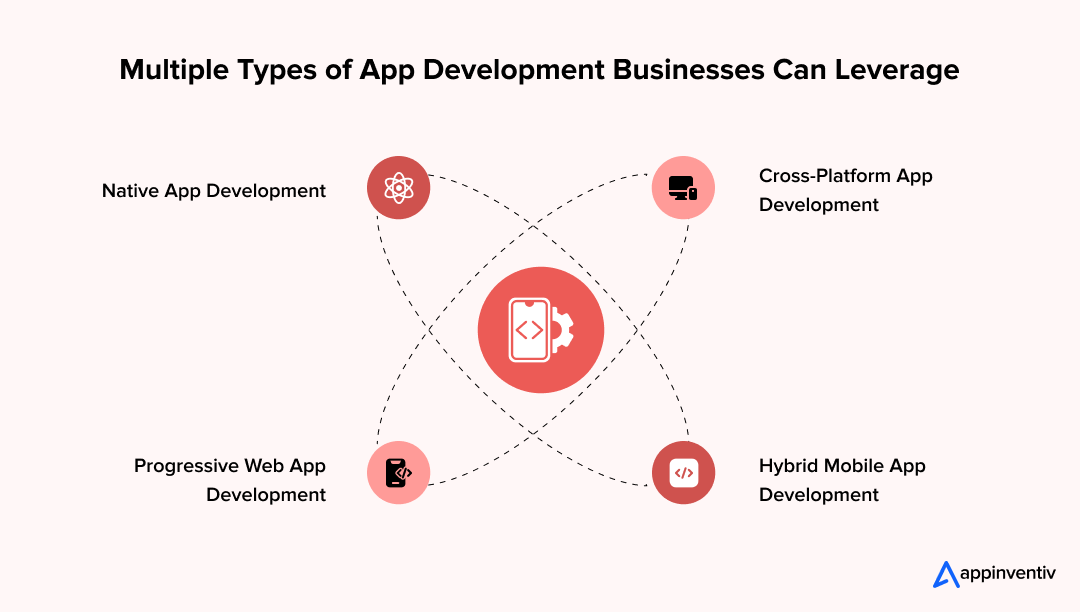
Native App Development
The idea of native app development is to have two apps individually for Android and iOS. Businesses often opt for native app development when their app’s goals align more closely with one platform.
Generally, when businesses are looking for a greater user base they opt for Android, and when it is revenue that they are after, they choose iOS app development.
Apart from their overall goals, there are several other reasons why native app development is a better solution for a business than cross-platform or web apps. Whatever the number of reasons pushing you to the native route, the platforms you can scale to are only two – Android and iOS.
Next, we will look into both options individually.
Android app development – According to BusinessofApps, the current number of apps on Google Play Store is around 3.5 million. Android apps are usually the ideal solution for businesses looking to take their business to millions of active users globally.
There are many statistics that hint toward the growth tangent that Android apps are on –
These numbers and facts make Android app development for businesses synchronous to growth and access to the massive user base. The platform comes with the benefit of multiple revenue sources, the freedom to customize the app and a very low barrier to entry. All the benefits together make it ideal for businesses to invest in Android apps.
iOS app development – With over 2.2 million apps available to download on App Store, the iOS market is chosen by businesses not for its high user base but for its potential to generate high revenue for the brands who make their presence on the store.
Analyzing the top mobile usage statistics and trends helps businesses understand user behavior and make informed decisions when entering the iOS app market.
Revenue comparison: iOS vs. Android
According to BusinessofApps, iOS catered to 68% of app consumer spending in 2024. The reasoning behind this difference in revenue can be attributed to the fact that Apple has established its market in some of the most developed, economically sound nations like the US and Australia. And it is due to these factors that have brought in a series of iPhone app development benefits for businesses.
Apart from this, the strict guideline that Apple has set for the brands looking to make an appearance in the App Store, in terms of quality, is also something that the users are willing to pay for.
Cross-Platform App Development
While native app development is about developing two separate apps for Android and iOS individually, cross-platform app development is about developing one app and publishing it on both Android and iOS platforms together.
There are many advantages linked to cross-platform app development, such as code reuse, low development cost & efforts, and greater audience reach. But at the same time, they even come with a set of disadvantages, such as – differences in iOS and Android mobile app design, slow app updates, and lack of proper app quality.
The only way to ensure that your app is high on advantages and low on disadvantages is to make a wise decision regarding the selection of framework and iOS or Android library. For that, you can either go with the top cross-platform frameworks that companies offering dedicated mobile app development for businesses are relying on or consult your partnered app development agency to get insights on which iOS or Android development framework would best suit your needs.
Progressive Web App Development
Apart from the native and cross-platform app development, this is another option that is marking itself as one of the best options for businesses looking to increase their reach while eliminating the restrictions coming in from the Play Store & App Store.
Here are a few advantages of progressive web apps:
- Progressive enhancement
- Mobile app-like experience
- Progressive web design
- Re-engagement at its best
- Work offline
- Feature-rich
Also, progressive web app development has established itself as the future of mobile apps by giving the end-users exactly what they want – Quick in and out time and saving the device memory size.
Hybrid Mobile App Development
A hybrid mobile app is based on the web view which runs on a web application in a native browser. These are viewed in UIWebView and WebView for iOS and Android, respectively. These types of apps are built using app development languages such as CSS, HTML, and Javascript, and then Cordona is used for wrapping them into native apps.
Hybrid app development is more cost-effective as compared to native apps. You just need to write the code once and then use it for multiple platforms. It renders user experience and performance close to native apps.
Comparison of different types of app development
| Parameters | Native app development | Cross-platform app development | Hybrid app development | Progressive web app development |
|---|---|---|---|---|
| Definition | These apps run natively on the platform of your choice | Cross-platform app development is about developing one app and publishing it on both Android and iOS together | It is based on the web view which runs on a web application in a native browser | Progressive web apps are hybrids of regular web pages and native apps |
| Tools and technologies used | Java, Kotlin, Python, etc. | Xamarin, NativeScript, Node.js, etc. | Objective C, Ionic, HTML5, etc. | Javascript, Ruby, CSS, etc. |
| Advantages | 1. Greater user experience 2. Direct access to the device’s APIs | 1. Single code for multiple platforms 2. Easy to maintain app | 1. Only one codebase is required for a hybrid app 2. Access to device’s internal APIs and device hardware | 1. The same app runs on web and mobile. Hence, it has less expensive upfronts 2. No need to install or update as it is accessible through URL |
| Performance | Fastest speed and efficiency as it is directly built on OS’s platform | The need for an additional abstraction layer and rendering process makes the cross-platform app slower than its native counterpart | Slower than native and cross-platform apps as they are not usually optimized for their platform | Progressive web apps can be decently fast, but their speed is entirely dependent on internet connection |
How Appinventiv Helped KFC Launch 7 Mobile Apps in a Single Year Leading to Massive Results?
As a dedicated mobile app development firm, Appinventiv played a pivotal role in transforming the fast food giant KFC’s digital strategy by successfully launching seven distinct mobile apps within a single year. This strategic collaboration focused on enhancing KFC’s customer engagement, operational efficiency, and overall brand presence.
From intuitive user interfaces designed for quick food ordering to specialized apps for managing loyalty programs, every application was crafted with precision and care. The apps further featured real-time tracking, personalized recommendations, and interactive elements like gamification to boost user retention.
The results of this massive undertaking were remarkable, with KFC experiencing significant improvements. Here are some of the outcomes of our collaboration with KFC:
- 22% increase in overall conversion rate.
- 4.5 average rating across locations on both the Play Store and App Store.
- Over 50% of total orders coming through the app.
- Over 60% increase in repeat purchases across channels.
- Increased ‘stickiness’ among customers ordering from the app.
- Highest Customer Lifetime Value (CLTV) across all order modes.
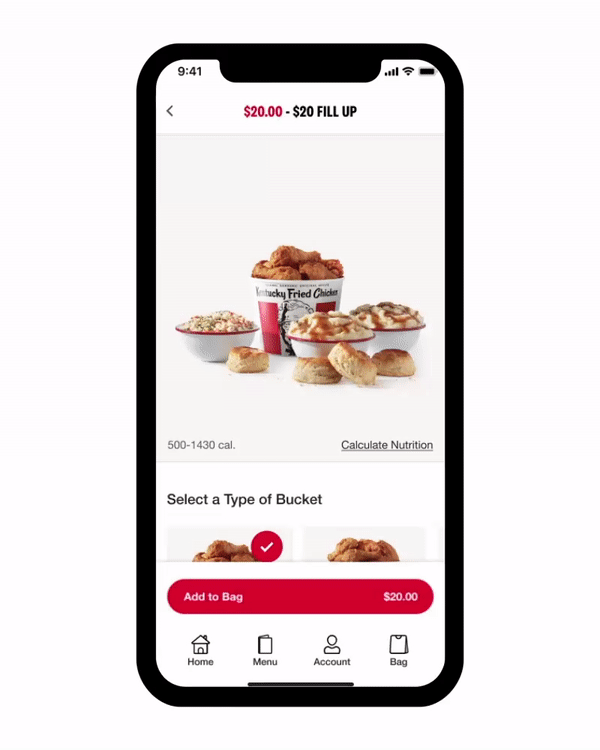
Now that we have witnessed how Appinventiv and KFC’s collaboration resulted in the brand’s massive digital transformation, it’s time to look into the latest mobile app development trends that you must know in 2024.
Mobile Application Development Trends Businesses Need To Look Out For
The future of mobile app development is being shaped by rapid advancements in technology, evolving user expectations, and a growing demand for seamless digital experiences. As businesses compete to capture and retain user attention, innovation in app development has become more crucial than ever.
In this section, we will highlight the key tech trends in the app development industry and how they are playing a huge role in customer retention and enhancing customer experience.
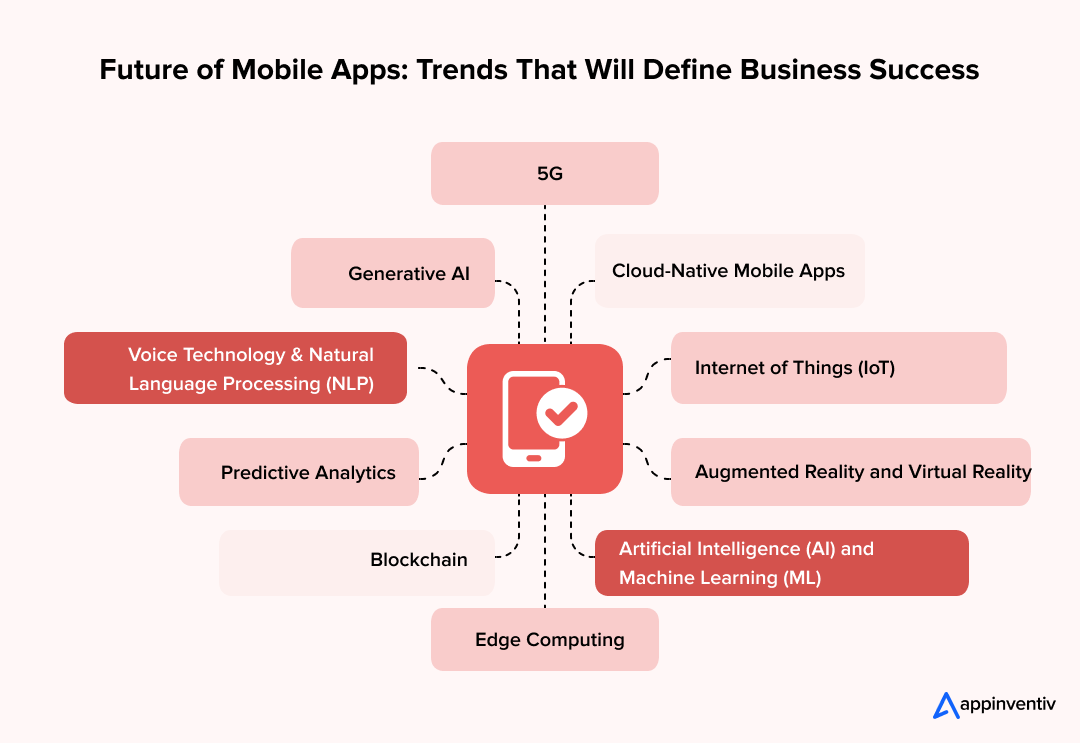
Generative AI
Generative AI is emerging as a game-changer in the mobile app development ecosystem, transforming how applications are built and interacted with. By leveraging advanced machine learning algorithms, this technology enables apps to generate content such as text, images, and videos in real-time, enhancing user engagement and personalization.
Beyond content creation, it also improves app functionality, allowing developers to automate tasks and build more intuitive user experiences. As businesses continue to explore its possibilities, integrating generative AI into mobile applications is becoming essential for innovation and competitive advantage.
Internet of Things (IoT)
The Internet of Things refers to the vast network of smart devices connected to the internet, all communicating and sharing data. In mobile app development, IoT enables users to control and monitor these devices remotely, whether it’s adjusting a thermostat, locking a door, or viewing home security feeds.
This seamless integration between mobile apps and smart devices enhances user convenience and supports smarter living and working environments. As IoT adoption grows in industries, its synergy with mobile applications is expected to deepen across industries.
5G
5G is revolutionizing mobile app development by dramatically improving network speed, bandwidth, and latency. It allows developers to incorporate data-heavy features like augmented reality, real-time streaming, and enhanced multiplayer gaming without compromising performance.
With reduced load times and improved responsiveness, mobile apps can now deliver smoother, more interactive experiences. 5G also benefits the development and testing process, enabling faster uploads, real-time collaboration, and cloud-based app functionalities.
[Also Read: 5G and IoT: Emerging Technologies with Endless Use Cases]
Augmented Reality and Virtual Reality
AR and VR technologies are expanding far beyond gaming and entertainment. AR enhances the real world by overlaying digital content through mobile devices, enabling practical use cases such as virtual try-ons, navigation assistance, and immersive product demos. VR, on the other hand, creates fully immersive environments and is often used in gaming, training simulations, and educational apps.
Both technologies are increasingly being adopted in business-focused mobile applications to deliver engaging and interactive user experiences that blur the line between digital and physical.
[Also Read: AR/VR Trends and Predictions For The Upcoming Years]
Predictive Analytics
Predictive analytics uses AI and machine learning to analyze historical data and anticipate user behavior, preferences, and needs. Mobile apps can leverage this to personalize content, recommend products, and optimize user journeys.
By predicting what users want or need next, businesses can improve retention, enhance engagement, and drive more meaningful interactions. As mobile apps become more data-driven, predictive analytics is proving crucial in creating smarter and more user-centric experiences.
Artificial Intelligence (AI) and Machine Learning (ML)
AI and ML have been integral to mobile app development for years, but their full potential is only beginning to unfold. These technologies allow apps to learn from user behavior and adapt in real time, making interactions more intuitive and personalized. Use cases include facial recognition, speech processing, predictive maintenance, sentiment analysis, and intelligent search.
From backend optimization to enhancing front-end user experience, AI and ML help build smarter, more efficient, and highly responsive mobile applications that evolve with user needs.
The best example of this can be cited through Appinventiv’s collaboration with JobGet, an AI-powered job platform that connects hourly and frontline workers with employers in real time. By streamlining the job application process, enabling instant messaging, and simplifying interview scheduling, the platform has transformed how employers and job seekers connect.
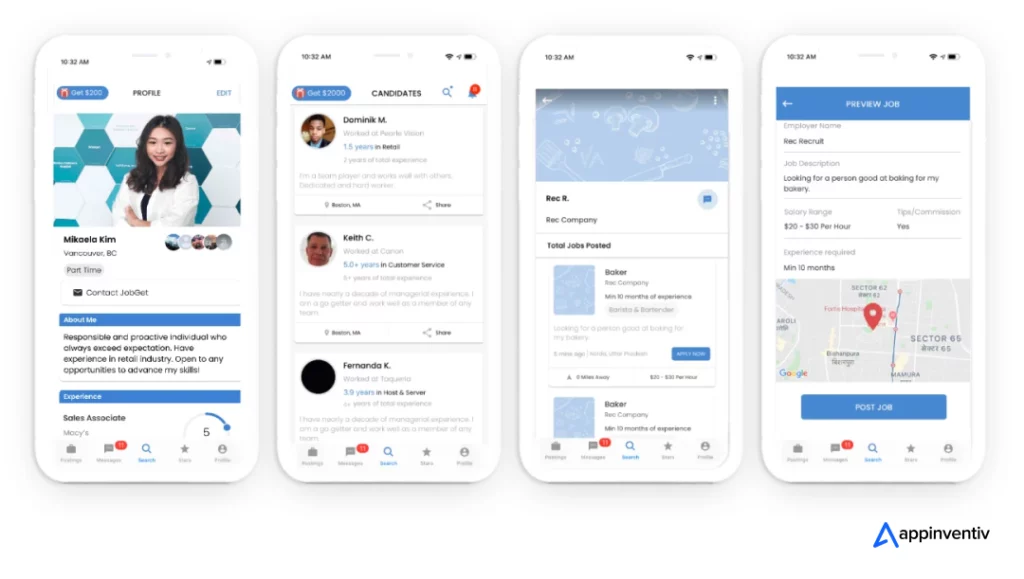
The impact has been significant—JobGet secured $52 million in Series B funding, fueled nationwide expansion, and successfully placed over 150,000 job seekers through real-time matching, revolutionizing the job search experience for a traditionally underserved workforce.
Edge Computing
Edge computing improves mobile app performance by processing data closer to the user—on the “edge” of the network, rather than relying solely on centralized cloud servers. This approach significantly reduces latency, speeds up real-time data processing, and increases reliability, especially in bandwidth-sensitive or time-critical applications.
It’s particularly beneficial for apps that require instant decision-making, like in logistics, connected vehicles, or IoT-based systems. With edge computing, developers can deliver more responsive and resilient user experiences, even in low-connectivity environments.
Blockchain
Blockchain is redefining how mobile apps manage data and transactions by introducing a decentralized, tamper-proof system. It enhances security, ensures transparency, and improves user trust, especially in apps that deal with sensitive data or financial exchanges.
By using distributed ledger technology, blockchain enables secure data validation, smart contracts, and traceability across multiple parties. This makes it ideal for use cases such as fintech, supply chain, identity verification, and digital voting. Integrating blockchain into mobile apps allows businesses to offer secure, auditable, and transparent digital experiences.
Also Read: An Entrepreneur’s Guide on the Blockchain Technology and Its Uses
Voice Technology & Natural Language Processing (NLP)
With advancements in natural language processing and its usage in businesses, mobile apps are evolving into more conversational and intuitive interfaces. Voice technology allows users to interact through commands, dictate messages, conduct searches, and receive real-time translations, enabling seamless, hands-free experiences. This tech is especially impactful in accessibility-focused apps and multitasking environments.
AI engines like Siri, Google Assistant, and Alexa are driving this shift, helping apps understand context, sentiment, and user intent with greater accuracy. Voice and NLP integration is rapidly becoming a critical part of mobile application development, enhancing both engagement and functionality across sectors.
Cloud-Native Mobile Apps
Cloud-native development empowers apps to be faster, scalable, and more resilient by leveraging cloud services like AWS Amplify, Google Firebase, and Microsoft Azure. These platforms offer serverless computing, real-time databases, scalable storage, and built-in authentication, making backend operations more efficient.
This approach allows developers to deploy updates faster, ensure cross-device data consistency, and reduce infrastructure costs. Apps built on cloud-native principles are also more secure and better equipped to handle user traffic spikes. It’s becoming a go-to strategy in the mobile app development process for businesses focused on performance, uptime, and long-term scalability.
Who Should You Entrust Your App Development Process to?
When it comes to getting an app developed, you will have three viable options -.
- Develop the app in-house
- Invest in an offshore agency
- Invest in a freelancer developer
Out of all the three options, outsourcing the service to an offshore mobile app development company is the most common one. It is estimated that around 47% of companies around the world outsource their software development services from offshore companies.
Outsourcing your app development project is one of the sure-shot ways for cost optimization, allowing you to leverage specialized skills and advanced technology within your desired budget. This approach not only enhances efficiency but also provides access to a wider talent pool, enabling rapid scaling and adaptation to market needs without the need to hire, train, and maintain a rather highly expensive in-house team.
Furthermore, with the rapid increase in the offshoring culture, outsourcing partners are also capable of bridging additional resources and compliance knowledge to the table, paving the way for your app’s success.
Let us now look into the details of hiring a mobile app development company before we move on to looking into the hiring requirements for mobile app developers.
How to Choose the Right Mobile App Development Company
Finding the right mobile app development partner is a crucial decision that can determine the success or failure of your app. With countless agencies in the market, it’s essential to evaluate them beyond surface-level promises and focus on tangible experience, expertise, and transparency.
Company Analysis
Thoroughly analyzing the company you’re planning to partner with is the first and most important step in the hiring process. Below are the critical elements to evaluate when choosing a mobile app development company:
Technical Expertise Across Platforms
Ensure the company has deep technical knowledge of both iOS and Android platforms, including native development with Swift, Kotlin, and Java, as well as cross-platform technologies like Flutter, React Native, or Kotlin Multiplatform. They should also be proficient in APIs, SDK integrations, cloud services, and performance optimization.
Ask about their familiarity with platform-specific guidelines (App Store vs. Play Store) and how they handle security, scalability, and maintainability throughout the mobile app development process.
Industry-Relevant Experience
Experience in your industry significantly shortens the learning curve and helps developers build more context-aware features. For example, an app for healthcare, fintech, or eCommerce will each come with its own user behavior patterns, regulatory compliance needs, and technical complexity. Review their past projects to see if they’ve tackled challenges similar to yours and can offer domain-specific insights that add value to your business mobile strategy.
Quality of Portfolio and Design Standards
A portfolio is a direct reflection of a company’s capability. Examine their featured case studies and live apps, paying attention to interface design, navigation flow, consistency, and innovation.
A strong portfolio should also demonstrate backend integrations, scalable infrastructure, and a seamless UI/UX strategy. Ask if they offer full-cycle services—from ideation and wireframing to prototyping and launch, or only selected phases of app development.
Client Reviews and Market Reputation
Authentic client reviews offer a window into real-world performance. Look for consistent high ratings and detailed testimonials on platforms like Clutch, GoodFirms, and Google Reviews.
Prioritize companies that have worked with recognized brands or startups in your industry. Also, check for certifications, awards, and partnerships with technology leaders such as AWS, Google Cloud, or Microsoft, which can signify a higher level of technical and professional credibility.
Defined and Transparent Development Process
A structured development process ensures clarity, accountability, and timely delivery. Ask how the company handles each stage of the mobile app development process, from discovery, business analysis, and sprint planning to design, development, QA, and deployment.
Inquire about their development methodology (Agile, Scrum, Waterfall), communication tools (Jira, Slack, Trello), and how frequently they provide updates. A clearly defined roadmap with milestones, timelines, and documentation is a strong sign of a reliable partner.
Questions to Ask Potential Development Companies
Hiring the right app development partner is a critical step in your mobile app journey. The outsourcing market is full of uncertainties, ranging from agencies that fail to understand your vision to those that leave projects incomplete. To avoid costly mistakes and ensure long-term success, it’s crucial to ask the right questions before sealing the deal.
Here are essential checkpoints to help you evaluate a mobile app development company effectively:
- How did your agency start, and who are the key team members? (Understanding company history and leadership helps evaluate trustworthiness.)
- Can you walk me through your design engagement process and the deliverables at each stage?
- What are the major variables or risks you foresee in this project, and how would you manage them?
- What is your approach to quality assurance and testing? Do you conduct both manual and automated tests?
- How do you ensure best-in-class technical documentation and knowledge transfer post-launch?
- Do you offer long-term maintenance and post-launch support? What does that include?
Mistakes to Avoid When Developing Mobile Applications
Now that we have explored the various platform options available for mobile application development and the latest technology trends, it’s time to delve into the common issues and mistakes associated with the mobile app development process, which can negatively impact your future in the mobile domain.
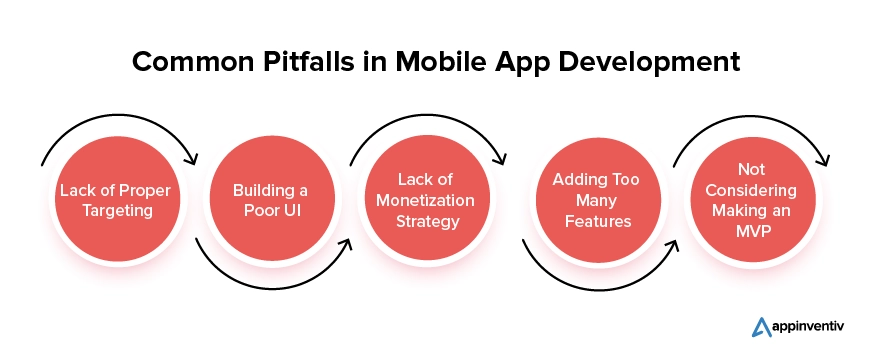
Lack of Proper Targeting
If your app doesn’t reach the target audience, it does not stand a chance of being downloaded. This is one of the biggest reasons why mobile apps fail. Therefore, it’s crucial to question and implement strategies rather than rush into mobile app development.
First thing is to understand the target market, the trends, and the usage statistics of your target audience. The second step is to identify what your competitors are doing well and what they are lacking. This helps increase the retention and installation rate of your application and interaction with the target audience.
Building a Poor UI
Another common mistake to avoid when developing an app is not paying close attention to the UI of your app. The UI, or user interface, is the face of your app, responsible for making a lasting first impression. Since there are numerous apps available on app stores, users are highly impatient when deciding whether to keep an app on their mobile devices.
In other words, a good UI is the key to user retention, which cannot be ignored. The mobile design process is a vital step in building an app that the users will embrace. The following are some of the points to take care of while designing the app UI:
- Never start designing without an app flowchart.
- Always pay attention to the resolution – Avoid designing for low resolutions.
- Consider minimizing or avoiding animations in the app’s intro. Users often prefer to access the main features quickly, and an unskippable intro may lead to frustration, potentially causing them to uninstall the app.
- Take extra care to ensure the animations used to indicate loading time are smooth and seamless. Use things that will keep the users engaged.
- One advanced feature to add to the UI is a gesture-based interface.
Lack of Monetization Strategy
During mobile app development for businesses like yours, there will be costs incurred right from production to outsourcing a team and post-deployment. To offset these expenses and generate a profit in the long run, it is crucial to select the right monetization model. There are numerous ways to monetize your application, including paid ads, in-app purchases, subscriptions, and more. Regardless of the monetization model you choose, ensure that it is profitable in the long run.
Adding Too Many Features
If you think that adding too many features will make your app more appealing to users, well, you might be wrong. Having too many features within the app makes it cumbersome and bulky in size without adding much value to the overall user experience. In contrast, having few targeted and important features makes a mobile app easy to understand and useful. In addition, having too many features increases the load time and makes the app slower.
Not Considering Making an MVP
An MVP presents you with a chance to test your product in real market conditions and get user feedback that helps improve your app’s performance. Developing an MVP as a preliminary product reduces the overall development time and costs. You can also receive valuable feedback from the market, make the required changes to your app’s model, and improve the final product. Hence, it’s advisable to build an MVP for the success of your application.
Key Considerations Before Developing a Mobile App
Before jumping into development, it’s essential to evaluate the strategic, technical, and financial aspects of your app. These key considerations will help align your vision with practical execution, ensuring a smoother development journey and a successful product launch.
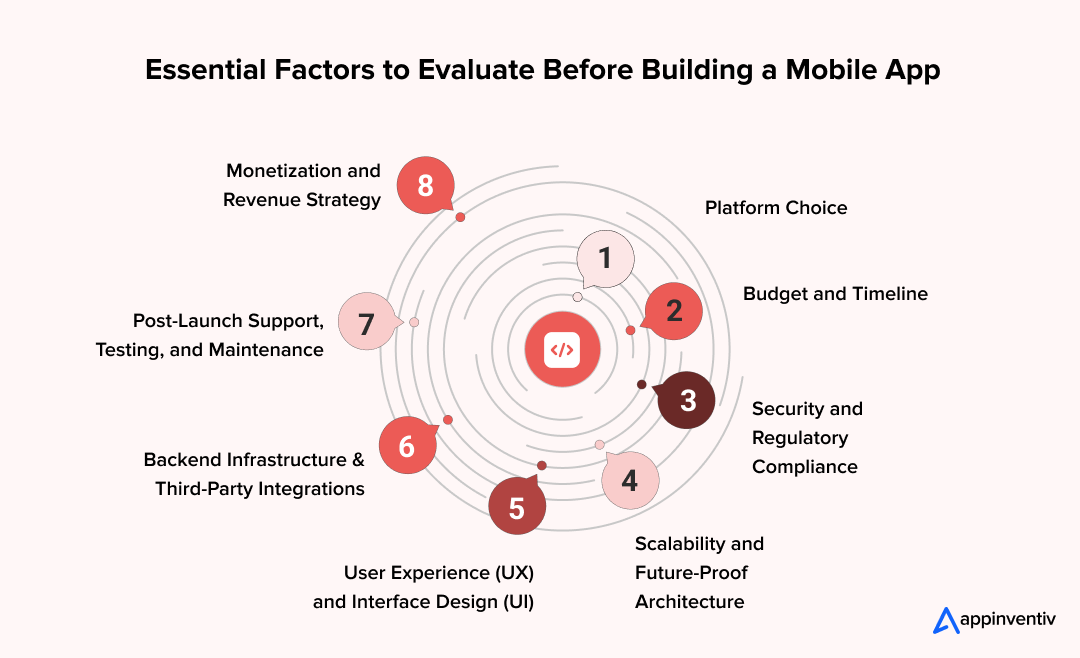
Platform Choice: iOS vs. Android vs. Cross-Platform
Selecting the right platform is a foundational step in mobile application development. iOS offers consistency, high performance, and a premium user base, making it ideal for apps targeting North American and Western European markets. Android, on the other hand, provides a broader reach, particularly in Asia and emerging economies, but requires extensive device testing.
Cross-platform frameworks like Flutter or React Native help reduce development time and cost while offering access to both platforms. Your decision should align with your audience, budget, and app goals to ensure long-term success. A thoughtful platform strategy can also simplify maintenance and future upgrades.
Budget and Timeline
Your app’s features, complexity, and technology stack will directly influence the mobile app development process in terms of cost and duration. Native apps, though powerful, tend to be more expensive due to dual development for iOS and Android. Hybrid apps are cost-effective and faster to deploy but may compromise on performance in certain cases.
Hybrid vs Native app development ultimately comes down to your project goals—if high performance, seamless user experience, and access to device-specific features are priorities, native development is the way to go.
Web apps are the most budget-friendly but come with limited native capabilities. A typical timeline ranges from 2 to 12 months depending on project scope. Planning the development in milestones or phases helps manage costs and ensures timely delivery.
Security and Regulatory Compliance
Data privacy and regulatory compliance are critical when it comes to business mobile app development, especially if you’re dealing with sensitive user data or operating in regulated sectors like healthcare or finance. Implementing robust encryption, secure APIs, and multi-factor authentication is essential.
Compliance with laws such as GDPR, HIPAA, PIPEDA, or PHIPA ensures your app meets legal standards while building user trust. Regular security audits and updates should be part of your post-launch maintenance plan. Neglecting compliance can lead to severe financial and reputational damage.
Scalability and Future-Proof Architecture
A scalable backend ensures your app can handle increasing traffic, data load, and feature extensions—key aspects of mobile app development for business. Opting for cloud-native infrastructure allows your app to grow seamlessly without performance degradation.
Building modular architecture helps integrate emerging technologies like AI, IoT, or 5G in the future. It’s also vital to keep your app compatible with new OS versions and devices. Thinking ahead saves costs on refactoring and positions your app to adapt in a fast-evolving digital landscape.
User Experience (UX) and Interface Design (UI)
Great UX/UI is at the core of successful business app development. Your app should be intuitive, visually consistent, and aligned with user expectations. Design wireframes and interactive prototypes early on to validate flow and usability. Prioritize fast loading times, responsive layouts, and easy navigation to reduce friction.
Accessibility features, such as voice support or high-contrast modes, should also be considered to serve a broader audience. A well-designed user experience enhances retention, app ratings, and overall ROI.
Backend Infrastructure & Third-Party Integrations
A robust backend system is the backbone of any high-performing app in the mobile application development journey. Whether you need real-time data syncing, user management, or third-party integrations (like payment gateways, CRM, or social login), your backend should be scalable and secure.
Consider using REST APIs or GraphQL for smoother communication between frontend and backend. Also, plan for load balancing and uptime monitoring tools to ensure your app runs efficiently under peak loads. Choose the tech stack based on the app’s needs and future scalability.
Post-Launch Support, Testing, and Maintenance
The real work starts after the app goes live. A key part of the mobile app development process is ensuring continuous improvement through updates, bug fixes, and new feature rollouts. Regular testing, both manual and automated is vital for quality assurance, especially when OS or device updates are released.
Monitor app performance using analytics tools to track crashes, user behavior, and feature engagement. Maintenance also includes managing cloud resources, security patches, and addressing user feedback. Dedicated support ensures user satisfaction and long-term success.
Monetization and Revenue Strategy
Before launching, define how your app will generate revenue, a critical part of developing mobile applications that sustain business growth. Common strategies include in-app purchases, ads, subscriptions, and one-time purchases. The choice depends on your industry, target audience, and long-term goals.
Freemium models work well for consumer apps, while B2B apps might thrive on licensing or tiered subscriptions. Revenue mechanisms should be seamlessly integrated to avoid disrupting user experience. Test and optimize monetization through analytics and user feedback post-launch.
Understanding Cost of Mobile App Development
One of the most critical components in a business’s mobile strategy is understanding how much it costs to build a mobile app. The answer isn’t always straightforward—because there’s no one-size-fits-all pricing model. The mobile application development cost can range anywhere from $30,000 to $300,000+, depending on various technical and business variables.
The actual investment depends on a multitude of factors, including the app’s core purpose, target platforms (iOS, Android, or both), feature set complexity, UI/UX design standards, backend infrastructure, and even where your app development agency is located. By breaking down these elements, businesses can make more informed budgeting decisions and choose the right business app development approach that aligns with their goals.
| Mobile App Development Cost Breakdown by Factor | ||
|---|---|---|
| Cost Factor | Description | Estimated Cost Range |
| App Type & Purpose | Varies based on whether the app is informational, eCommerce, social, SaaS, or enterprise-grade. | $30,000 – $250,000+ |
| Platform (iOS, Android, or Both) | Native (single OS) apps cost less; developing for both increases the price. | Single: $30,000 – $80,000 Both: $60,000 – $150,000 |
| App Complexity | Refers to features like real-time chat, AR, AI, or offline mode. | Basic: $30,000 – $50,000 Moderate: $50,000 – $120,000 Advanced: $120,000 – $250,000+ |
| UI/UX Design Requirements | Includes custom animations, branding, and interactions. | $5,000 – $30,000 |
| Backend Infrastructure | Cloud setup, database design, API development, and admin panels. | $10,000 – $80,000 |
| Third-party Integrations | Payment gateways, chat SDKs, CRMs, analytics tools, etc. | $5,000 – $50,000+ |
| Geographic Location | Rates vary significantly by region. | India: $25 – $50/hr Eastern Europe: $40 – $90/hr USA/UK: $100 – $250/hr |
| Maintenance & Updates | Annual updates, OS compatibility, bug fixes, and feature improvements. | 15% – 20% of initial dev cost/year |
| Testing & QA | Manual and automated testing for cross-device performance. | $5,000 – $20,000+ |
Mobile App Monetization Strategies for Businesses
Creating a successful app goes beyond great design and functionality; it also requires a solid revenue strategy. Whether you’re a startup or an enterprise, integrating the right monetization model is essential to making your app financially sustainable.
Below are the key strategies businesses use while developing mobile applications that not only deliver value to users but also ensure long-term profitability.
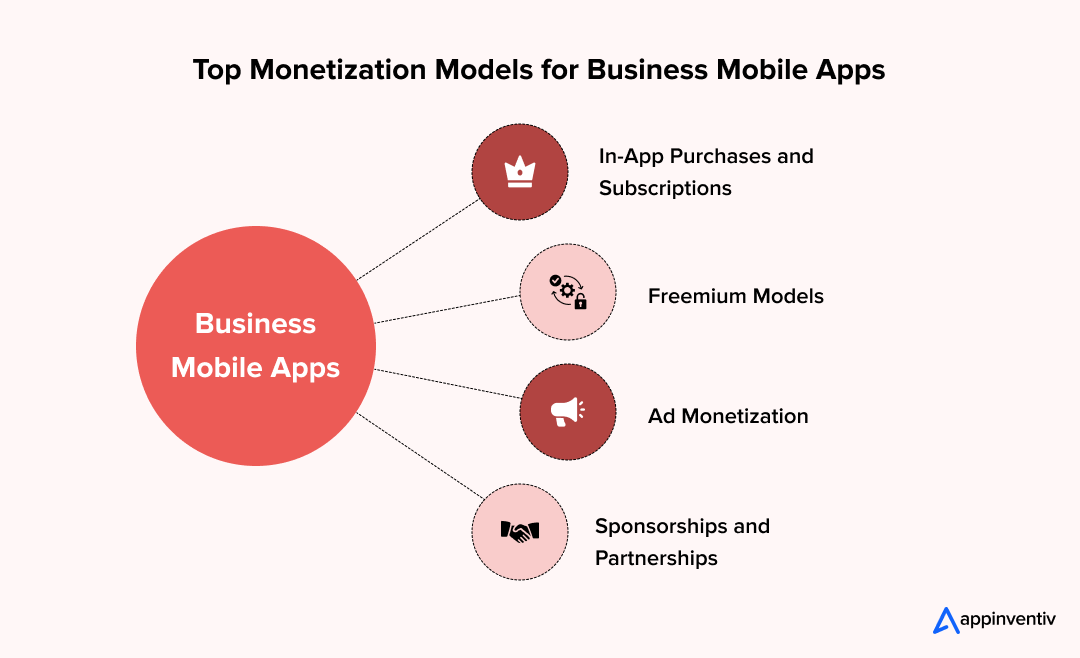
In-App Purchases and Subscriptions
One of the most effective and scalable monetization models, in-app purchases (IAPs) allow users to buy virtual goods, extra lives, features, or digital content within the app. Meanwhile, subscription models offer recurring access to premium content or features, creating a predictable revenue stream.
This approach gives users control over their spending while letting businesses segment access levels through pricing tiers. It’s commonly used in industries like fitness (e.g., guided workout subscriptions), gaming (e.g., character upgrades), education (e.g., exclusive courses), and streaming (e.g., ad-free content). Its versatility and ability to scale across different user groups make it a cornerstone of mobile application development strategies worldwide.
Freemium Models
The freemium model blends mass accessibility with premium monetization. Users are granted access to essential features for free, with the option to unlock advanced capabilities or remove limitations through a one-time payment or subscription.
This model encourages user onboarding at scale, reducing friction during adoption while building trust before conversion. It works particularly well for productivity tools, health trackers, photo editors, and language learning apps. Freemium models have become a staple for companies developing mobile applications in highly competitive environments, where retaining users long enough to convert them is crucial for profitability.
Ad Monetization
Advertising is a go-to strategy for free apps that prioritize user acquisition and engagement. Through integration with ad networks such as Google AdMob, Unity Ads, or Facebook Audience Network, developers can display a variety of ad formats, including banner ads, native ads, interstitials, and rewarded videos.
Rewarded ads, in particular, incentivize users by offering in-app perks in exchange for ad views, striking a balance between monetization and experience. This model generates passive income without directly charging users and is most effective for apps with high daily active user bases. It’s a common choice in business app development, especially for apps in the news, gaming, social, and media streaming sectors, where session times are high.
Sponsorships and Partnerships
This model enables mobile apps to generate revenue through strategic collaborations with brands or businesses. Sponsors may pay for ad placement, exclusive campaigns, or co-branded content, while partnerships can involve affiliate marketing, content integrations, or shared product offerings.
Apps with a well-defined niche or a highly engaged user base often attract sponsors looking for targeted exposure. For example, a fitness app might partner with a supplement brand, or a travel app might feature hotel deals. Sponsorships add authenticity to the app while diversifying income sources, making them a smart component of long-term mobile app development planning for sustainable business growth.
Let our experts help you monetize your app successfully
Mobile App Development for Businesses: Issues That Arise and How to Resolve Them
While mobile apps have become a powerful tool for business growth, the development process often comes with its fair share of hurdles. From financial constraints to security and performance issues, businesses must navigate these obstacles strategically. Below are the most common challenges in business app development, paired with actionable solutions to help overcome them.
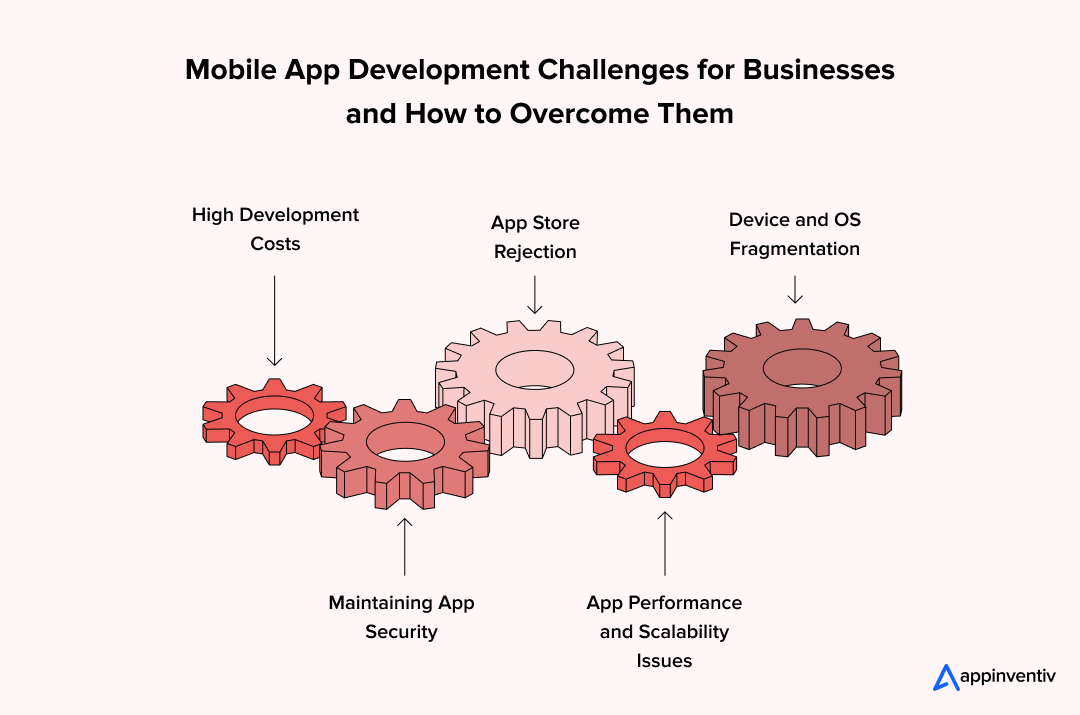
High Development Costs
Building a high-quality, feature-rich app can be expensive, especially when factoring in design, development, testing, deployment, and maintenance. Costs can escalate further with cross-platform demands, third-party integrations, and advanced features like AI or AR.
Solution: Opt for MVP (Minimum Viable Product) development to launch quickly with essential features and validate your idea. Utilize cross-platform frameworks, such as Flutter or React Native, to minimize development time and costs. Outsourcing to a reliable mobile application development company with scalable pricing models can also help manage budgets without compromising quality.
Maintaining App Security
With rising data breaches, mobile apps handling sensitive user information are prime targets for cyber threats. Security lapses can lead to compliance violations and loss of user trust.
Solution: Implement end-to-end encryption, secure APIs, multi-factor authentication, and data anonymization. Regularly update the app to patch vulnerabilities. Partner with developers experienced in secure mobile app development, particularly in regulated industries like healthcare or finance.
App Store Rejection
App stores have strict and constantly evolving guidelines. Non-compliance with policies related to content, permissions, or privacy can result in app rejection, delaying launch and impacting business plans.
Solution: Stay up to date with Apple App Store and Google Play guidelines. Conduct a pre-submission checklist covering performance, privacy policies, data permissions, and device compatibility. A seasoned development partner can ensure your app aligns with platform-specific rules before submission.
App Performance and Scalability Issues
Slow loading, crashes, or bugs, especially during user traffic spikes, can lead to poor reviews, reduced engagement, and churn.
Solution: Focus on performance optimization during development. Use lightweight code, compress media, and apply lazy loading techniques. Ensure the backend is cloud-based and scalable using platforms like AWS or Firebase. Regular performance testing should be a core part of the mobile app development process.
Device and OS Fragmentation
With thousands of devices, screen sizes, and OS versions in the market, ensuring consistent app performance can be difficult.
Solution: Use responsive design, adaptive layouts, and thorough cross-device testing. Leverage cloud-based device testing platforms like BrowserStack or Firebase Test Lab to test across various devices and OS combinations. Choose tech stack for mobile app development that support wide compatibility from the outset.
How Appinventiv Can Help in Your App Development Journey
We hope our mobile app development guide has offered you a deep insight into the world of app development for businesses and how it can prove beneficial for your overall success. With over nine years of experience and having delivered more than 3000 successful projects, our mobile app development services experts are adept at transforming innovative ideas into successful mobile apps across various industries. Here’s why we are the ideal partner for your app development needs:
Customized Solutions
We pride ourselves on creating bespoke solutions tailored to each client’s unique requirements. Our approach ensures that your app not only meets but also adapts to your business needs and customer expectations.
Scalable Applications
We design applications with scalability in mind, allowing for seamless upgrades and expansions as your business grows and evolves over time. This forward-thinking approach ensures your app remains effective in the dynamic market landscape.
Agile Development Process
Our agile development methodology promotes flexibility, rapid iteration, and continuous feedback, ensuring that the final product is refined and aligned with the latest market demands and user preferences.
Cross-Platform Expertise
With proficiency in both iOS and Android platforms, we deliver high-quality, cross-platform apps that provide a consistent user experience across all devices, which is vital for maximizing your app’s reach and user engagement.
Data Security and Compliance
We prioritize the security of your data with stringent compliance to the latest industry standards and regulations. This commitment helps protect your company’s and users’ data from potential threats and breaches.
Get in touch with our mobile app development experts if you are looking to enhance customer interaction, streamline operations, or simply capture new markets with a robust mobile app.
FAQs
Q. Why is mobile app development crucial for businesses in today’s digital era?
A. In today’s digital landscape, mobile app development offers businesses a direct communication channel to reach and interact with their target customers, streamline operations, and drive innovation. These apps play a crucial role in elevating customer satisfaction, generating essential data analytics, boosting brand recognition, and creating additional revenue streams.
Q. How long does it take to build an app?
A. To give you a rough estimate, the overall time frame of developing a mobile app is directly proportional to the overall app complexity. For instance, a highly complex app with an extensive feature set can take around 12+ months. On the other hand, a simple app with minimal features can take around 4 to 6 months, depending on the project goals.
Q. What are the common mistakes to avoid when building a mobile app?
A. Here are a few common mistakes one should avoid when creating an app:
- Not paying attention to UI
- Not concentrating on building an MVP
- Lack of proper targeting
- Lack of monetization strategy
- Adding too many features
Q. What is the cost of developing a mobile app?
A. The average mobile application development cost ranges from $25,000 to $300,000+. This broad estimate varies based on several factors including the app’s complexity, its features, and functionalities. More complex apps with advanced features like real-time synchronization, augmented reality, or extensive data integration will cost more. Additionally, factors such as the development platform (iOS, Android, or both) and the location of your development team can also influence the final cost.
Q. What should an entrepreneur know before developing an app?
A. Here are some of the key aspects that every entrepreneur should consider before developing an app:
- Market Research: Understanding your target audience is crucial. Identify their needs, preferences, and pain points.
- App Concept & MVP (Minimum Viable Product): Start with a simple, functional version of your app.
- Platform Selection: Decide whether to develop for iOS, Android, or both.
- User Experience (UX) and User Interface (UI): A seamless, easy-to-navigate interface is essential.
- App Development Cost: Understand that app development involves several phases, including design, coding, testing, and launch.
- Compliance and Legal Concerns: Be aware of regulations such as GDPR for data privacy and intellectual property issues like patents, copyrights, and trademarks.
- Monetization Strategy: Consider how you’ll generate revenue from the app, whether it’s through ads, subscriptions, in-app purchases, or paid downloads.
- Marketing and User Acquisition: Plan your strategy for acquiring users. Pre-launch marketing and post-launch app promotion can help drive installs and build awareness.
- App Maintenance: Be ready to provide regular updates and bug fixes based on user feedback and technical performance.
Q. How can I monetize a mobile app?
A. Applying these strategies can help you in app monetization:
- In-App Ads
- In-App Purchases (IAP)
- Subscription Model
- Paid App Downloads
- Freemium Model
- Affiliate Marketing
- Sponsorship and Partnerships
- Crowdfunding
Q. What makes a mobile app successful in today’s market?
A. A successful mobile app focuses on user retention through strategies like push notifications, rewards, and personalized experiences. It’s scalable to handle growing user bases and maintains robust security and privacy measures to build trust.
Effective app marketing, including app store optimization, social media promotion, and referral programs, drives visibility and downloads. Balancing monetization without hindering user experience and continuously updating the app with new features ensures long-term success in a competitive market.


- In just 2 mins you will get a response
- Your idea is 100% protected by our Non Disclosure Agreement.
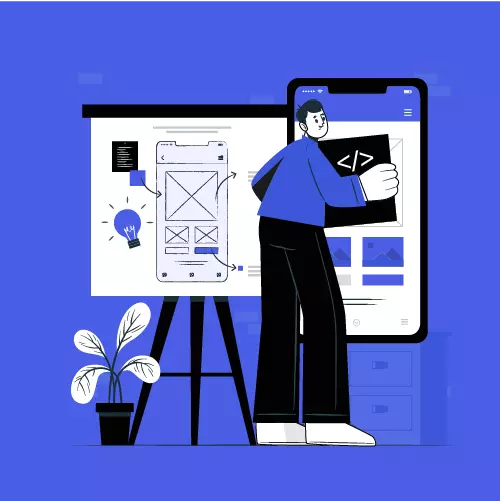
Every successful business today shares one common thread: they've mastered the art of meeting customers where they spend their time. And increasingly, that place is iOS devices. While many companies are still debating whether mobile apps are worth the investment, smart businesses are already reaping the rewards of iOS mobile app development.

The well-intentioned shift to the decentralized universe, also known as Web 3.0, has radically increased the demand for blockchain technology. The latter can revolutionize businesses and transactions, allowing business owners to create a robust, well-designed, and transparent distributed system capable of ensuring maximum ROI. Enterprises are swiftly integrating blockchain technology into their operations to revolutionize…
